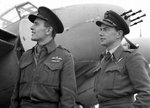Chocks away!
Senior Airman
I don't know if this has been discussed before in these forums, but it's something i have difficulty understanding:
Why on earth did RAF pilots go into the trouble of flying level with a V-1, positioning his fighter's wing beneath the buzz-bomb's and flipping it over, as opposed to just shooting it down?!
Why on earth did RAF pilots go into the trouble of flying level with a V-1, positioning his fighter's wing beneath the buzz-bomb's and flipping it over, as opposed to just shooting it down?!


